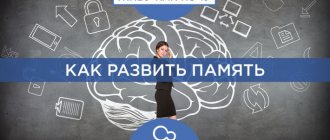Sometimes you can hear about a person: “He is completely devoid of imagination!” Basically they say this about people who don’t know how to fantasize. But is the development of fantasy and imagination really necessary for modern man? Scientists claim that imagination is as important a mental process as thinking, memory, and attention. Without it, there will be no great discoveries and works of genius, inventions necessary for humanity. Life itself will become boring and dull without imagination.
Imagination expands the possibilities of cognition and transformation of the world around us
What is imagination for?
Imagination is a mental process necessary to create new images based on existing ideas. Is it really necessary for everyone? Maybe we should leave it to artists, designers, inventors and other people called upon to create new images?
According to psychologists, none of the intelligent beings can do without imagination, since it sets thoughts in motion, helps to go beyond the present and comprehend the future, awakens feelings, and contributes to the making of plans. It originated in the process of labor on the basis of thinking and memory, which means it works in inextricable connection with them. Without imagination, the entire human psyche will become impoverished.
Interesting. A synonym for imagination is fantasy, this action is known to everyone. Fantasy accompanies a person’s childhood, making it memorable and not boring. All types of children's activities are associated with imagination.
Ways to develop imagination
Mnemonics for memory development for adults and children - methods and techniques
The activity of imagination is most evident in younger children and adolescents who are learning about the world around them. Some of its aspects are sometimes not understandable in reality, so imagination comes to the rescue, for example, how to imagine the Universe, other worlds, extinct animals, the life of ancient people. Psychologists say that if preschool children have a rich imagination, then the cognizable world will be more diverse for them.
What about adults, is their imagination really more meager? Many experts assure that every adult can and should think about how to develop imagination, since work, study, and life circumstances sometimes require non-standard solutions.
Using effective methods you can develop your creative imagination
Psychology knows effective ways to develop imagination:
- Visualization is the simplest action, which consists of mentally reproducing a certain object in detail. To master this technique, it is better to start with easy and pleasant playback. For example, at work, imagine a cozy evening with a cup of coffee, imagine every detail, remember the aroma, taste, connecting as many senses as possible. In this way, different events can be reproduced. If you have difficulty visualizing real events, you can use incidents from books.
- Association is a classic that can be found in any logic textbook. The essence of the technique is to select others for a given image that are associated with it, that is, connected. For example, the word “vacation”, you need to select all the words for it that will enrich it: train, plane, trip, suitcase, sea, seagulls, sun, beach, sand, excursion. The more images are selected, the better the imagination develops. The peak of development can be a situation when not only real, but also abstract concepts are combined. For example, sad, cheerful, life, beauty.
- Creativity is a fun way for the imagination to work. It is human nature to create, to create beauty in the environment. In modern life, this technique is known as a hobby. You can come up with unique things: paintings, new fashions, designer interiors, works and much more, without which human life is impossible. If you don’t have enough ideas for inspiration, you need to go where there are plenty of them: an art gallery, an exhibition of contemporary art, unique objects. It all depends on what a person wants to do.
- Play is the simplest and most exciting way to develop imagination. Currently, various educational games, the essence of which is the creative control of a character or action, are becoming popular among adults and children: “Imaginarium”, “Da Vinci’s Riddles”, “Tetris” and many others.
Games and creative activities help to imagine and fantasize
In adults
It’s not for nothing that they say that an adult remains a child at heart, so it is possible to use all the techniques that are usually used in relation to children. Playful and creative activities may have a different meaning, but they will delight adults no less. Psychology websites offer a variety of imaginative games that people can incorporate into their daily lives. Moreover, you don’t need to find extra time in your busy work schedule to play. You can play on the way to work and home, in a traffic jam, on vacation, when meeting with friends. The most popular:
- Doodles (English doodle - scribbles, riddle - riddle) are abstract images in which you need to see images of some objects. With a good imagination, you can see several images in one picture. There are no right or wrong answers to the task, the main thing is an original solution.
- “Burime” (French bouts-rimés – “rhymed ends”) is a literary game, the main rule of which is the composition of comic quatrains on a given topic. It’s better to take unexpected and strange rhymes, which will help strain your brain, fantasize, and come up with humorous continuations. To begin with, rhymes from any poem will be useful, for example, rays of streams, snow of meadows.
- Creative hobbies, such as knitting, sewing dolls, embroidering pictures, drawing, weaving, bead paintings, puzzles and much more, help improve imagination. The main thing is to find time for your favorite activities, where you can give free rein to your imagination.
A person needs to find time and opportunities to work on improving his imagination
In children and adolescents
Creative play tasks are good for developing children's imagination. The main goal is to fantasize based on creating new images from the proposed elements:
- In practice, the classic exercise “Blots” is often used, which will interest not only the baby, but also the school-age child. No special preparations are required. Take a sheet of paper, fold it in half, and apply a drop of liquid paint to the middle of the fold. You need to iron the fold and unfold it again. Consider the resulting blots, imagine what it could be? It is useful to organize a competition for the most non-standard solution.
- The development of imagination is facilitated by tasks on the topic “Imagine and complete the drawing.” The cycle of such exercises includes drawing unfinished contours, which is useful for creative imagination.
- Outdoor games are good for developing imagination for any year of life, starting from preschool age. They are especially useful in families with children of different ages. For example, the elder throws a ball with a word, the child must return it with a word denoting a new image of the same object. The funnier the new image, the more interest in the exercise. For example, a writing pen, a reading book, walking shoes, a carrying bag. The one who comes up with the most funny images wins.
Imaginary processes
In the psychology of cognitive processes, a unified definition of imagination has not been developed. In each of the proposed definitions, the authors highlight those aspects that, in their opinion, are the most striking and important features of the imagination, distinguishing it from other mental processes. Most authors consider the main content of the imagination process to be the transformation of ideas that reflect real reality, and the creation on this basis of new ideas that bring images into a new combination.
A feature of imagination can be considered that it necessarily proceeds visually, although the resulting images do not have an original in reality, and these images cannot be obtained empirically or logically. The material for imagination, as a rule, is images of objects, situations, circumstances and, according to some authors, also thoughts and ideas. The main action in the process of imagination is representation, “which is aimed at reproducing and mentally changing a particular representation.”
There is another point of view, according to which imagination is not considered as an independent mental process, since, according to supporters of this point of view, the transformation of an image and the discovery of a new image, traditionally identified as the main features of the imagination, are necessary aspects of any process of sensory reflection of reality and functions all mental processes.
Traditionally, types of imagination are considered passive and active, which differ in the degree of a person's conscious and active relationship to reality. In turn, passive imagination is divided into intentional (voluntary) and involuntary (involuntary, which usually manifests itself in borderline states), and active imagination is creative, that is, the creation of new, original images and ideas, and recreational, which is based on the creation of images that correspond to description.
However, some authors deny the usefulness of dividing the imagination into the reconstructive and the creative, since “any division of cognition into reproductive and productive is false, since it excludes any possibility of transition from the first to the second.” The peculiarity of the creative imagination itself is that it is “a conscious process that occurs in the active mental activity of the subject and is subordinated directly or indirectly to a task being realized - scientific, artistic or practical.”
In accordance with the temporal orientation, types of imagination can be divided into retrospective (memories of imagination); imagination directly involved in the activity being carried out, and imagination directed to the future.
According to the nature of the appearance of images, imagination can be divided into concrete, controllers, of which there are concrete images and ideas, and abstract, expressed in the creation of symbols and diagrams.
Depending on the type of activity during which the imagination functions, there are technical, musical, scientific, artistic and other types of imagination.
L.M. Wecker characterizes imagination as “a continuous mental process, symmetrical to memory, but having the opposite direction” and proposes a classification based on the properties of the material, the object of mental activity. This approach allows us to distinguish between sensory-perceptual imagination (in the strict sense), which includes: visual,
- auditory,
- motor,
- spatial and possibly other types of imagination;
- verbal-logical (conceptual), which acts as an element of thought;
- emotional imagination.
As a special type, it is assigned to operational imagination, defined as the active functioning of imagination images as a program of activity.
Indicators of imagination productivity are characterized by novelty, originality and meaningfulness of processing empirical data; the breadth of work with images, which is understood as the ability to perform transformations from various materials, the type of operation (available type of transformation), which can be characterized by either changing the position of an imaginary object, or changing its structure, or a combination of these transformations.
Simple exercises to train your imagination
Development of thinking in an adult and a child - recommendations
Psychologists offer many simple but effective exercises for developing thinking and flights of imagination that are suitable for people of all ages. Their main advantages are simplicity and accessibility. Everyone is able to find in the flow of information the exercise that will appeal to a particular person. For example:
- Counting in your head is accessible and interesting to everyone who has school knowledge. There is no need to use any notes, just count mentally. The exercise is especially useful for those who are good at mathematics. You can fantasize about geometric shapes, mentally building all sorts of combinations from them.
- Paradoxically, you can watch children's cartoons with your child and use them as a workout for your mind and imagination. It's helpful to watch them without sound and then come up with funny dialogue. The funnier the better for the imagination.
- The simplest way relates to the world of books. Reading detective stories or fantasy is becoming fashionable; it will benefit both imagination and fantasy.
- “Nonsense piggy bank”, where you can put interesting things: thoughts, pictures, ditties, jokes - everything that is considered nonsense. If necessary, you can always get an idea for a creative solution from there.
- Collective games are becoming fashionable, then it’s time to get some old-time fun out of the box. For example, "Pantomime", in which players must guess what action is being depicted. Creative imagination develops based on memory, since you need to remember what picture the participants are depicting.
Simple exercises will help your imagination fly
Creating images
A person creates images in the imagination in several ways:
- Agglutination. The qualities and parts of individual objects are combined into a single whole. Examples: centaur, fairy-tale hut on chicken legs, seaplane, snowmobile.
- Emphasis. Part of the object is divided into separate parts. A good example is caricatures in which the artist highlights a certain feature.
- Hyperbolization. Involves reducing, enlarging, or shifting individual parts of the selected object. Here you can also remember fairy tales, for example, about dragons with several heads.
Another way to create images in the imagination is typification. It is considered the most difficult. Imagine any picture. Contemplating it, you draw in your subconscious the image that the artist conveyed. Or take, for example, a book. The author describes in it the features of the main character. Thanks to this, you can imagine how he looks, thinks, behaves. It is as if you are transported into the world around him.
Developing imagination for creativity and drawing
How to develop memory in a child of preschool and school age
Usually, when talking about the formation of imagination in the field of creativity, they mean younger children. But many adults are also not averse to devoting their free time to drawing. Psychologists have proven that the passion for drawing stops such a serious disease as Alzheimer's disease, which has long been associated with the development of intelligence. The lower it is, the greater the chance of getting sick and, conversely, creatively developed people avoid brain disorders. Many people understood this, and a fashion for creative pursuits came into life. How to develop imagination to create unique things?
A short effective course in developing creative imagination:
- manipulations with photographs - take photographs of nature and find familiar images in them;
- following Leonardo da Vinci’s formula “to see images even in wall cracks,” you can use images of stones, wood cuts, shadows of objects;
- books and drawing manuals - will help you get inspired by ideas for creativity, study the manner of drawing in different directions, choose what pleases your soul;
- thematic exhibitions and art galleries - will suggest topics for independent creativity;
- collages, appliqués are an effective way to develop imagination;
- drawings from life, even unsuccessful ones, according to professionals, will help develop creative abilities and give room for imagination.
Drawing and creativity help fight dangerous diseases
Developing creative imagination is the best investment in your mental health; having a rich imagination is a gift from above that prevents life from turning into a boring, gray existence.
Example from life
I enjoy reading. Imagination helps you immerse yourself in the story. Even seemingly tedious descriptions of the area become much more interesting. I try to see the landscape through the eyes of the author, hear sounds, feel the wind or the scent of flowers.
The same goes for heroes. I try to imagine not only their appearance, but to monitor how their behavior and thinking changes in different situations. Thanks to this, after reading the book, it seems that I have visited this book world.
Video
Device for combing cats and dogs Discounted item (No. 66)
665 ₽ More details
Furminator for dogs FURMINATOR S for small short-haired breeds
1739 ₽ More details
Nipple drinkers for rabbits










